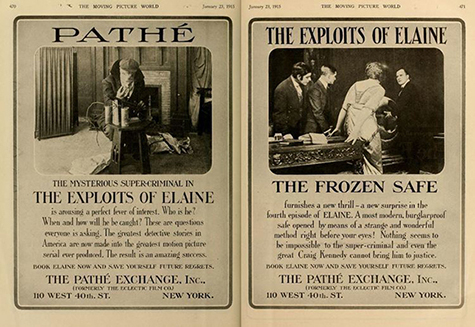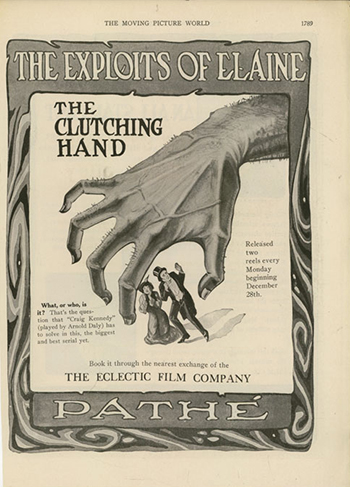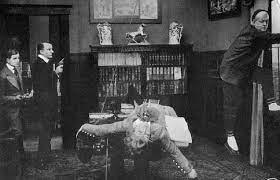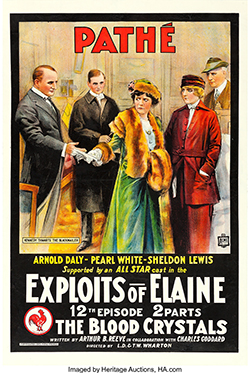E …is for
The Exploits of Elaine
The Exploits of Elaine (1914) was the first and most successful serial produced by the pioneering filmmakers brothers Theodore and Leopold Wharton. The story of Elaine Dodge, the eponymous and enterprising young heroine who dedicates herself to solving the mystery of her father’s death at the hands of an anonymous villain, Elaine was reportedly the first picture to earn over a million dollars at the box office. And it later became the first serial to be selected for inclusion on the National Registry of Films by the Library of Congress.
As Pathé-Hearst’s The Perils of Pauline (1914) neared its conclusion, newspaper tycoon-turned-movie producer William Randolph Hearst was determined to create a new serial that would afford his star, reigning serial queen Pearl White, an exciting encore. The Whartons, recognizing that the chance to be associated with Hearst’s enterprise was an unparalleled opportunity to move beyond short pictures and to make their own singular contribution to the increasingly popular serial genre, were only too happy to oblige. Drawing on narrative patterns that earlier serial filmmakers had introduced, the brothers brought to the screen their memorable heroine, a “New Woman” type who manifests progressive thinking, athletic talents, and a taste for adventure that belie outmoded notions of feminine behavior and societal roles. At the same time, they were able to redefine a number of the conventions of the serial, which later filmmakers would emulate and adopt.
With a screenplay written by Charles W. Goddard, George B. Seitz, and Basil Dickey, and directed by prominent directors Seitz and Louis Gasnier in conjunction with the Whartons, the serial was based largely on the “Craig Kennedy, Scientific Detective” sequence by American author Arthur B. Reeve. Often called the “American Sherlock Holmes,” Reeve’s Kennedy used both science and intuition to solve challenging mysteries. Walter Jameson, a young reporter at the Star newspaper, served as his Dr. Watson. Almost every story—and later, almost every serial episode derived from those stories—incorporated one or more technological devices that Kennedy invented or utilized and that were vital to the resolution of the plot. While common today, those devices—which included wireless telephones, laser lights, and portable X-ray machines—were revolutionary more than a century ago when the Whartons brought them to the screen.
Of course, a great detective required a worthy opponent. And the mysterious “Clutching Hand” offered just that. The first in the serial genre’s anonymous and menacing antagonists, the Clutching Hand established a new type of villain, whom audiences reviled and filmmakers adored for years to come. Since his real identity was concealed until the final episode, he added even more carryover mystery to the visual action and served as an excellent device for sustaining audience interest throughout the months during which the serial drama ran. All of the episodes (except for the last), in fact, ended with a close-up of his tightly-clenched fist, followed by a large question mark.
The real star of the serial, however, was unquestionably Pearl White, the most iconic of the serial queens of her day. White had already amassed a huge following, both nationally and internationally, with her breakthrough role as Pauline in The Perils of Pauline; and, with Hearst’s powerful publicity machine solidly behind the Elaine serial, she seemed to be everywhere. Her fashionable costumes, which set new trends, were widely imitated; her face appeared almost daily in the Hearst press, splashed across the front pages of newspapers and magazines. And stories about her on-screen and off-screen adventures abounded, perpetuated by the Hearst press and the proliferating fan magazines.
An undeniably modern woman who defies both traditional gender roles and social expectations, Elaine is at once fearless yet feminine, determined but dutiful; and she appealed to men and women alike. The first episode established the premise of the serial and introduced the central characters. As the episode begins, Elaine’s father Taylor Dodge (William Riley Hatch) falls victim to the diabolical but faceless villain, leaving Elaine and Kennedy (Arnold Daly) to find his murderer. Over the next few episodes, they must resist the predations of the Clutching Hand, who continues to menace Elaine in various ways: by threatening her friends; by rigging an “infernal” trap that will release a hail of bullets, killing anyone in their path; and by using an invisible powder that contains arsenic to poison her. As the serial progresses, however, Elaine moves from mere victim of the Clutching Hand’s repeated assaults to a more active player in the drama. Unfortunately, a new villain—Chinese adventurer Long Sin (M. W. [“Mike”] Rale)—sets his sights on her as well and introduces new complications and new hazards, even at one point acting as a “ghost” in order to lure Elaine to a mysterious temple to be sacrificed. But, with the help of Kennedy and his many scientific inventions—including the “vocaphone” that transmits voices and messages, a seismograph that tracks the villain’s steps, a death-ray, and an electrical resuscitator that literally brings Elaine back to life—the identity of the Clutching Hand is exposed, and Kennedy and Elaine enjoy a warm and overdue reconciliation.

The ads for the serial teased audiences and hinted at the dangerous exploits ahead for Elaine (Pearl White).
The Exploits of Elaine was incredibly popular with moviegoers and profitable for the producers. Not surprisingly, two serial-sequels followed, the ten-part The New Exploits of Elaine and the fourteen-part The Romance of Elaine (both 1915), which introduced new adventures and new dangers for the heroine, including, in the former, the search for the fortune that the Clutching Hand had hidden at the end of the original serial and, in the latter, for a super-powered torpedo invented by Craig Kennedy that can revolutionize warfare and that foreign enemies covet. Audiences simply could not wait to learn how the irrepressible Elaine would surmount the seemingly endless perils in her path.
Survival Status: Episodes of the serial survive in various archives, including the George Eastman Museum, the Library of Congress, the Museum of Modern Art, Library and Archives Canada, UCLA Film & Television Archive, BFI National Archive, and National Film and Sound Archive of Australia. Episodes 2, 10, and 14 can be accessed on YouTube. Link: The Exploits of Elaine, Chapter 10 on YouTube, https://www.youtube.com/watch?v=EdlCSMkbQCU.
Directors: George B. Seitz, Louis Gasnier, Theodore Wharton, Leopold Wharton
Release Date: December 28, 1914
Release Company: Wharton, Inc. for International Film Service (an Eclectic Film Company production, distributed by Pathé Exchange)
Cast: Pearl White (Elaine Dodge), Arnold Daly (Craig Kennedy), Creighton Hale (Walter Jameson, episodes 1-3), Raymond Owens (Walter Jameson, episodes 4-14), Sheldon Lewis (Perry Bennett/The Clutching Hand), Edwin Arden (Wu Fang), LeRoy Baker (The Butler), Bessie Wharton (Aunt Josephine/Mrs. Dodge), Riley Hatch (Mr. Dodge), M. W. Rale (Long Sin), Floyd Buckley (Michael), Robin Townley, Lionel Barrymore, Howard Cody, George Seitz, Paul Panzer.
Episodes: 1. The Clutching Hand. 2. The Twilight Sleep. 3. The Vanishing Jewels. 4. The Frozen Safe. 5. The Poisoned Room. 6. The Vampire. 7. The Double Trap. 8. The Hidden Voice. 9. The Death Ray. 10. The Life Current. 11. The Hour of Three. 12. The Blood Crystals. 13. The Devil Worshippers. 14. The Reckoning.




